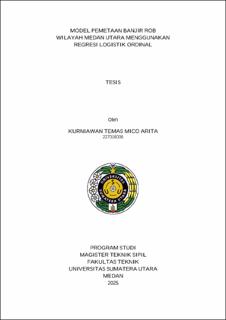| dc.description.abstract | Tidal flood is a frequent disaster in coastal areas, including in North Medan, which consists of Medan Belawan, Medan Labuhan, and Medan Marelan sub-districts. The impacts of tidal flood including infrastructure damage, disruption of economic activities, and a decline in environmental quality and community welfare. Therefore, this study aims to map the level of tidal flood vulnerability in North Medan using the Ordinal Logistic Regression (OLR) method combined with Geographic Information System (GIS) to obtain a more accurate prediction model. This study used nine main factors in the analysis of tidal flood vulnerability, namely rainfall, drainage density, land use, distance from the river, distance from the sea, soil type, elevation, slope, and topographic aspects. The results of the analysis show that the factors of rainfall, elevation and distance from the sea have the most significant influence in determining the level of tidal flood vulnerability in the study area. Based on GIS mapping, areas with a very high level of vulnerability cover 7.60% of the total study area, while the high category covers 64.74%. Meanwhile, areas with a medium level of vulnerability cover 27.36% and areas with a low level of flood vulnerability cover 0.3% of the total study area. The use of Ordinal Logistic Regression (RLO) provides accurate results, with a model accuracy rate of 88.75%. The results of this study can serve as a basis for local governments and stakeholders in disaster mitigation, better spatial planning, and the preparation of adaptation strategies to reduce the impact of tidal flooding in the coastal areas of North Medan. | en_US |


